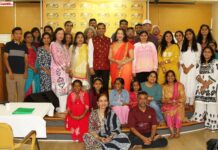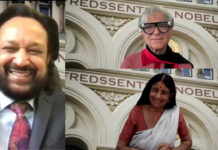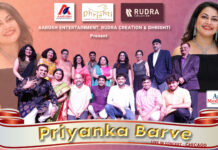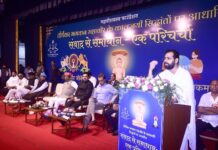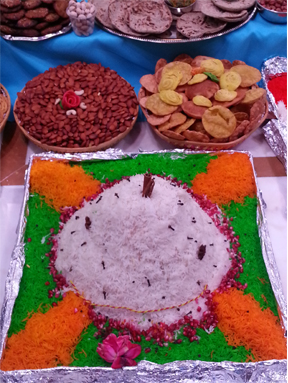 BARTLETT: On November 12, several thousand devotees and visitors flocked to the magnificent Swaminarayan temple in Bartlett, Illinois, to celebrate Annakut (also called Govardhan Puja) as well as the beginning of Hindu New Year.
BARTLETT: On November 12, several thousand devotees and visitors flocked to the magnificent Swaminarayan temple in Bartlett, Illinois, to celebrate Annakut (also called Govardhan Puja) as well as the beginning of Hindu New Year.
This joyous festival commemorates an event in Krishna’s childhood when he persuaded the local cowherds to make their annual offerings of harvest grains and pulses to Mount Govardhan instead of the god Indra, since it was the mountain’s fertile soil that provided the grass which nourished their beloved cows. Enraged, Indra sent a violent rainstorm to punish the people. Krishna lifted up Govardhan with his little finger and for seven days and nights held it over the people to shelter them from the rain.
To commemorate this event, a replica of Mount Govardhan was made and dishes offered to the mountain. At the end of the festival, the dishes are distributed to the worshippers as prasad. It is also an occasion to thank God for his providence and to seek his blessings for the coming year.
As a food writer and food historian, I was especially interested in the dishes prepared for Annakut at the Swaminarayan temple. My guide Kamala, a helpful young volunteer led me through the mandir and haveli which were both lined with displays of dishes. It would be impossible to name them all and what was most striking was how they combined the traditional and the modern. (All, of course, were vegetarian and had no onion or garlic).
Traditional sweets included many varieties of ghugra (gujia) –
Little fried pastries filled with khoa, coconut and sometimes dried fruits; laddus, jalebis, different kinds of halwa, magaj (a kind of burfi made from coarse chickpea flour), and barfis in every color of the rainbow.
The sweets were often piled to make miniature replicas of Mount Govardhan. There was a profusion of savories, including such traditional Gujarati snacks as handvo, batatanushaak (potatoes and spinach).
Crispy vada), patra and katles (vegetarian cutlets) as well as colorful dishes of artfully arranged rice.
But many of the dishes had an American inspiration: giant pretzels, pizza, donuts, baguettes, cookies, apple turnovers, elaborately decorated cakes (some wishing Happy New Year in English or Gujarati), and row upon row of cupcakes that formed a vibrant border for the displays.
Particularly impressive were miniature temples made of dough and a marvelous peacock with feathers made of butternut squash and beets. The creativity and labor of the cooks and all the volunteers was an impressive expression of their devotion on this important occasion.
Colleen Taylor Sen is a writer and food historian specializing in south Asia. Her most recent book is Feasts and Fasts: A history of Food in India (Reaktion Press, 2015)
Colleen Taylor Sen

